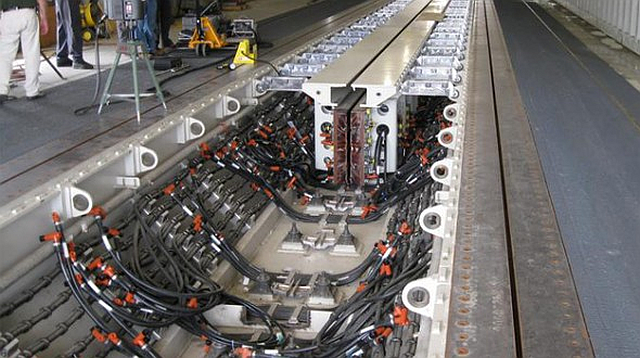Navy’s second home-built carrier will be nuclear, but will come only in 2030s
The navy has made its choices. When INS Vishal, the Indian Navy’s second indigenous aircraft carrier enters service, it will be a technologically cutting edge warship, on par with the world’s most advanced carriers.
The navy’s finalised specifications include nuclear propulsion, a catapult launch system based on the new US “electro-magnetic aircraft launch system” (EMALS) and the capacity to embark 55 combat aircraft.
But advanced technologies also mean delay. Naval planners, talking anonymously to Business Standard, say INS Vishal will not enter service before 2030, and might take as long as 2035 to join the fleet as India’s third operational carrier.
Already, the navy faces six years of delay in the first indigenous carrier, the 44,000-tonne INS Vikrant, which Cochin Shipyard Ltd was supposed to deliver in 2015. Until the Vikrant is commissioned in 2021, the navy will operate just a single carrier --- the 45,000-tonne INS Vikramaditya, built in Russia and commissioned in 2013.
Yet the navy’s decision is clear --- delay is acceptable, but INS Vishal must pack the power needed to effectively dominate India’s extended area of operations. Over the years, the navy has defined this as extending across the Indian Ocean, from the Strait of Hormuz in the west, to the Malacca Strait in Southeast Asia.
To dominate this swathe of sea, the navy believes the Vishal would need at least 55 aircraft on board. These will include two fighter squadrons, electronic warfare (EW) aircraft, airborne early warning (AEW) aircraft to monitor and control airspace, and helicopters for special operations, anti-submarine warfare and communications duties.
Given the capability-to-weight thumb rule of 1,000 tonnes of aircraft carrier needed for each aircraft embarked, INS Vishal would have to be about 60,000 - 65,000 tonnes. To propel such a carrier at a sustained 30 knots (over 55 kilometres per hour), a nuclear propulsion system has been considered inescapable.
India does not yet have a nuclear propulsion system suitable for an aircraft carrier. The 83 Megawatt (MW) nuclear reactors designed for the Arihant-class nuclear ballistic missile submarines (SSBNs) are inadequate, since an aircraft carrier requires several times more power than an SSBN.
Developing a new, purpose-built reactor remains an option, but planners could also attempt to modify the 540 MW nuclear reactors that India has developed for commercial power generation.
The navy has extensively debated the question of nuclear propulsion. Opponents of nuclear propulsion point to the Royal Navy’s 65,000 tonne Queen Elizabeth II, slated to be commissioned in 2017, which will be powered by Rolls-Royce MT30 gas turbines. Proponents of nuclear propulsion argue that India’s carriers would require more electrical power, since these would launch aircraft with the power-intensive EMALS system.
Even so, India’s carriers would be significantly smaller than the US Navy’s 95,000 tonne Enterprise-class; and the new 100,000 tonne Gerald R Ford-class supercarriers that embark 90-100 aircraft.
“We have conveyed our choice. Now the government will decide. An aircraft carrier has huge financial implications, with large annual outlays during construction and even while it is in service. So the government will understandably consider the choices carefully. And that means delay”, says a senior naval planner.
The government’s decision will be complicated by recent reductions in the naval budget. This year, allocations to the navy are down to just 14.55 per cent of the defence budget, from 18 per cent in 2012-13. Defence experts opine that, given the navy’s growing role and the cost of capital warships, an 18 per cent allocation is unavoidable.
Yet, in the wake of the Uri attack, a high-level empowered committee that visited Russia for emergency purchases of military equipment bought mainly army weaponry. The admirals worry that the current focus on tactical skirmishes with Pakistan on the Line of Control might shift focus from the strategic, long-term need to bolster the navy.
As Business Standard first reported (July 17, 2015, “
India specifies 65,000-tonne aircraft carrier, with catapult”) the navy last year specified INS Vishal’s approximate weight while seeking consultancy assistance from global shipbuilders in designing the carrier. But that request was silent on several key questions --- including nuclear propulsion and EMALS. Nor was there a completion date.
Another crucial question to be decided is what aircraft INS Vishal will embark. The MiG-29K, which were bought from Russia for the Vikramaditya and Vikrant, have limitations that are still being ironed out. Nor is the Naval Tejas light fighter making significant headway.
That opens the door for two bigger fighters that already fly off aircraft carriers: the French Rafale, already procured from Dassault for the air force; and Boeing’s F/A-18E/F Super Hornet, the world’s premier carrier-borne aircraft. With EMALS technology chosen for INS Vishal, the US fighter has a slight edge in this race.
http://ajaishukla.blogspot.nl/2016/11/navys-second-home-built-carrier-will-be.html






